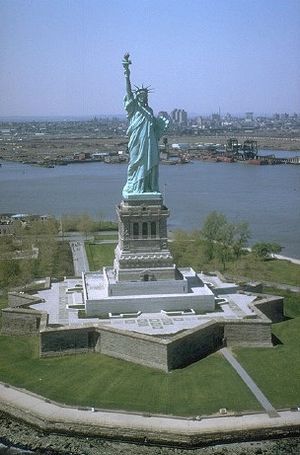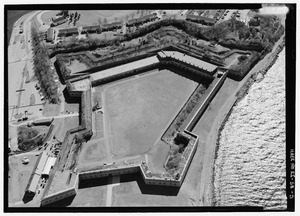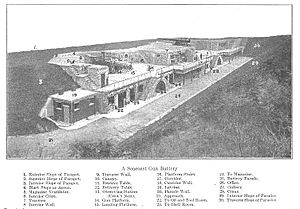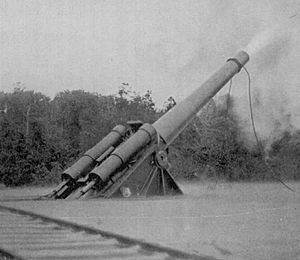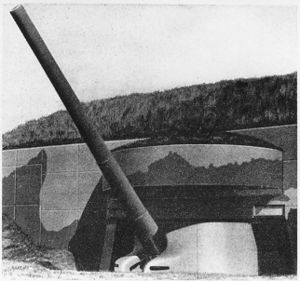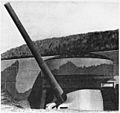List of coastal fortifications of the United States facts for kids
The United States and the colonies before it built many coastal defenses to protect important cities, ports, and waterways. These defenses were built from the colonial era all the way through World War II. Some of these forts were built by other countries and are now in the United States.
Contents
Protecting the Coasts: Forts Through Time
Early Forts: From Colonies to the Civil War (Before 1885)

Coastal forts in the American colonies and later the United States were usually built stronger than forts inland. They also had bigger cannons, similar to those on attacking ships. Historians group coastal forts built between 1794 and 1867 into three main periods, each with its own style of building.
The first two groups of forts (called the First and Second Systems) were mostly made of earth shaped into star forts, with some stone parts. They usually had one level of cannons on the roof or behind low earth walls. The First System forts were built from 1794 to 1801. The Second System started in 1802 because of problems with Britain and France, which led to the War of 1812. These early forts were simple and usually finished in two to five years.
The Third System of forts began after the British captured and burned Washington, D.C. in the War of 1812. These new forts were much larger and mostly built from stone. They typically had two or three levels of cannons; two forts even had four levels! Most of the cannons were inside protected rooms called casemates. These were the biggest stone forts the U.S. ever built. Many were designed by U.S. Army engineer Joseph G. Totten.
All forts built by the U.S. government were designed by the US Army Corps of Engineers. Until 1901, different artillery units protected these forts. After the Civil War, many units at the forts were called "heavy artillery batteries." Most forts were shaped like polygonal forts with strong walls to defend against attacks from both sea and land.
Work on the Third System forts started in 1819. These forts took many years to build, and many were not finished when funding stopped in 1867. The siege of Fort Pulaski in April 1862 showed that stone forts could be damaged by new, powerful rifled cannons. Because of this, funding for stone forts was stopped in 1867. New defenses were then built using earth protection with some stone, often near older forts. However, funding was cut again in 1876, leaving many of these new batteries unfinished.
Modernizing Defenses: Endicott Program to World War I
In 1885, a group called the Board of Fortifications, led by Secretary of War William C. Endicott, planned a new way to defend the coasts. They suggested new defenses for 27 harbors and river mouths. Most of their ideas were put into action in what became known as the Endicott Program.
This program included new, powerful rifled guns, from 3-inch to 12-inch. Most of these guns were placed on special disappearing carriages in new concrete bunkers covered with earth. The idea was to hide the guns from enemy ships. At this time, airplanes hadn't been invented yet! The program also included large 12-inch rifled mortars and hidden minefields in the water. Many Endicott batteries were built near or even inside older forts.
Building these new defenses took time. Progress was slow until the Spanish-American War in 1898. This war made people worry that the Spanish fleet might attack the U.S. east coast. Only a few new batteries were ready then, so emergency batteries were quickly built. These used older Civil War-era weapons, along with some new 8-inch guns and smaller rapid-fire guns bought from the United Kingdom.
In 1907, the soldiers who operated these large guns became part of a new group called the United States Army Coast Artillery Corps. The Endicott forts received full funding during and after the Spanish-American War and were mostly finished by 1906.
In 1905, another group, the Taft Board, met to plan more improvements. The U.S. had gained Hawaii and the Philippines in 1898, and the Panama Canal Zone in 1903. The Taft Board improved how guns aimed and fired at several harbors. They also decided to build new defenses in these new territories, as well as in Los Angeles, California. Since Japan was building warships with 14-inch guns, new 14-inch weapons were developed for these four new defense areas.
By 1917, with World War I happening, the Army decided on a new type of battery. These would have two 12-inch guns in open areas on high-angle carriages. This allowed the guns to shoot much farther. Existing 12-inch guns were used for these batteries. Most of these batteries were completed around 1920.
Between the Wars and World War II
After World War I, the Army tried to make more improvements, but there wasn't much money. A new 16-inch gun was adopted. It could fire shells in a high arc to hit targets from above. However, because of limited money, only eleven of these huge guns were ready by 1927. They protected important places like Boston, New York City, the Chesapeake Bay, and Pearl Harbor, Hawaii. The Navy also provided twenty 16-inch guns that were originally meant for battleships that were never built. Six of these were placed in Hawaii and Panama by 1935.
In 1938, construction started on two protected batteries for 16-inch guns near San Francisco. These casemates protected the guns from air attacks. After France fell to Germany in 1940, the Army decided to replace older defenses with new 16-inch gun batteries, usually with two guns each. Most existing 16-inch batteries were also given these protective casemates. Because these guns could shoot so far, most 16-inch batteries were built at new locations, often called "military reservations" to keep their purpose secret.
The long-range 12-inch batteries were also kept and given casemates. The Navy provided about 50 more 16-inch guns. These 16-inch batteries were supported by 6-inch guns and new 90 mm (3.5-inch) dual-purpose guns (which could shoot at both ships and planes).
As World War II continued, the threat of enemy ships attacking the U.S. coast, especially on the east coast, became smaller. Because of this, out of 38 planned 16-inch batteries, only 21 were finished, and not all of them even received guns. As the new 16-inch batteries were completed, the older, heavier weapons at the harbor defenses were removed and scrapped. By 1948, almost all remaining gun defenses were taken apart.
A Look at Some U.S. Coastal Forts
Many coastal forts were built across the United States. Here are a few examples from different states and time periods to show how they protected important areas:
| State | Name | Location | City or area defended | Era(s) | Activated | Deactivated as coastal fort | Deactivated as military post | Notes |
|---|---|---|---|---|---|---|---|---|
| Alabama | Fort Charlotte/Fort Conde | Mobile | Mobile | Colonial | 1723 | 1820 | 1820 | A smaller copy of the fort is on the site today. |
| Alaska | Fort Schwatka | Dutch Harbor | Dutch Harbor | World War II | 1944 | 1950 | ||
| California | Fort Rosecrans/Fort Guijarros | San Diego | San Diego | Colonial, Endicott, Taft, World War II | 1797 | 1950 | Part of the fort is now a naval base and a national monument. | |
| California | Fort Point/Fort Winfield Scott/Castillo de San Joaquin | San Francisco | San Francisco | Colonial, Third System | 1794 | 1900 | 1970 | Now a national park. |
| Connecticut | Fort Griswold | Groton | New London | Revolutionary War, Third System | 1778 | 1903 | 1903 | Restored and open to the public as a state park. |
| Delaware | Fort Delaware | Pea Patch Island | The Delaware | Third System, Endicott | 1824 | 1942 | 1944 | First stone fort finished in 1824, then rebuilt after a fire. Now a state park. |
| Florida | Castillo de San Marcos/Fort Marion | St. Augustine | St. Augustine | Colonial, Third System | 1672 | 1866 | 1933 | A national park. |
| Florida | Fort Pickens | Santa Rosa Island | Pensacola | Third System, Endicott, Interwar | 1834 | 1947 | 1947 | Part of a national seashore. |
| Hawaii | Fort Ruger | Diamond Head | Honolulu | Taft, Interwar, World War II | 1910 | 1946 | 1974 | Part of the Diamond Head State Monument. |
| Maine | Fort Knox | Prospect | The Penobscot | Third System | 1863 | 1916 | 1923 | A state park. |
| Maryland | Fort McHenry/Fort Whetstone | Whetstone Point, Baltimore | Baltimore | Revolutionary War, First System, 1870s | 1800 | 1912 | 1925 | A national park. The attack on this fort in the War of 1812 inspired "The Star-Spangled Banner". |
| Massachusetts | Fort Independence/Castle William/Fort Adams | Castle Island | Boston | Colonial, Revolutionary War, First System, Third System | 1634 | 1908 | 1946 | A National Historic Site. |
| New York | Fort Hamilton | Fort Hamilton, Brooklyn | Southern New York | Third System, Endicott | 1831 | 1948 | Has a museum and is still a military base. | |
| Oregon | Fort Stevens | Hammond | The Columbia | Endicott | 1836 | 1925 | 1948 | Was attacked by a Japanese submarine in WWII. Now a state park. |
| Puerto Rico | Castillo San Felipe del Morro/Morro Castle/Fort Brooke | San Juan | San Juan | Colonial, World War I, World War II | 1539 | 1950? | 1961 | |
| Rhode Island | Fort Adams | Newport | Narragansett Bay | First System, Third System, 1870s, Endicott | 1799 | 1943 | 1950 | A state park with large forts and batteries. |
| South Carolina | Fort Sumter | Charleston Harbor | Charleston | Third System, Endicott | 1860 | 1946 | 1948 | The attack on this fort in April 1861 was the first big event of the American Civil War. It's now a National Historic Monument. |
| Texas | Fort Travis | Bolivar Point | Galveston | Endicott, Interwar | 1900 | 1946 | 1947 | Now a park. |
| Virginia | Fort Monroe/Fort George | Old Point Comfort, Hampton | Chesapeake Bay | Colonial, Third System, Endicott | 1728 | 1943 | 2011 | A national park with a museum. |
| Washington | Fort Worden | Point Wilson, Port Townsend | Puget Sound | Endicott | 1900 | 1946 | 1953 | A state park. |
See also
- Seacoast defense in the United States
- Harbor Defense Command
- United States Army Coast Artillery Corps
- United States Army Corps of Engineers
- List of forts in the United States
Images for kids
-
Fort Amsterdam, the quadrangular structure (left) in this 1660 image stood at the southern tip of Manhattan Island, defending New Amsterdam



